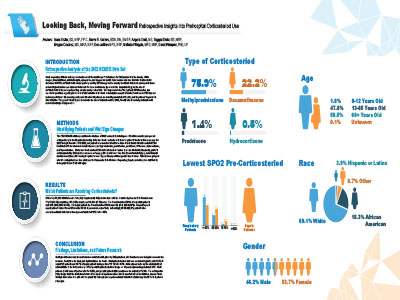Looking Back, Moving Forward: Retrospective Insights into Prehospital Corticosteroid Use
Author: Isaac, Kiarra R. Gaines, Angela Child, Taggart Diehl, Brogan Crockett, Dan Jeffries, Malinda Whipple, and David Wampler | |
Associate Authors:
<p><strong>Introduction:</strong></p>
<p>Sepsis and respiratory emergencies make up a significant percentage of emergency medical service (EMS) calls. However, the frequency of patients receiving prehospital corticosteroids remains unknown.</p>
<p><strong>Objective:</strong></p>
<p>To describe the use of corticosteroids by EMS, identify who is receiving corticosteroids, and determine what vital sign changes occur.</p>
<p><strong>Methods:</strong></p>
<p>The 2022 NEMSIS public research dataset was retrospectively analyzed to identify prehospital patients who received corticosteroids. Inclusion criteria: Received at least one dose of corticosteroid after arrival of EMS. Exclusion criteria: Calls not 9-1-1 scene calls (interfacility transports), patients not transported, patients with fewer than two recorded vital signs, cardiac arrest, and transport times greater than 3 hours. Patients were grouped into three categories based on initial provider impression ICD-10 codes—respiratory, sepsis, and other—then stratified by demographics and initial vital signs.</p>
<p><strong>Results:</strong></p>
<p>Of the 53,179,492 NEMSIS encounters, 94,536 (0.18%) met the inclusion criteria. Groups were 77,800 (82.3%) respiratory, 475 (0.5%) sepsis, and 16,261 (17.2%) other. The lowest recorded SpO2 of respiratory patients was 92% (IQR = 86%–96%). For sepsis patients, SpO2 was 88% (IQR = 82%–93%). Respiratory and sepsis patients had a 4% and 6% median SpO2 improvement, respectively. Interestingly, patients who received corticosteroids (60,375 [63.9%]) had the lowest precorticosteroid SpO2 of ≥ 90%.</p>
<p><strong>Conclusion:</strong></p>
<p>Methylprednisolone was the most common prehospital corticosteroid given, and most patients treated had no or modest hypoxia. The retrospective study design limits the ability to determine if the cause of improvement was due to coadministered medications.</p>
|
|
|
|

